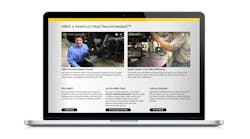Customer service index (CSI) reports are great tools to learn about your shop’s strengths and weaknesses from the customer’s perspective. Every shop should rely on that feedback for constant improvement, but should not always gauge success of the business solely based on that information.
That’s because CSI reports don’t always tell the whole story, says Geoff Laramy, training and development manager for 3M. Many customers only respond when they have something negative to say, and CSI reports generally don’t offer specific explanations regarding the factors that caused a particular rating.
Sometimes, he says, the best way to obtain performance feedback is to ask customers directly. Shops can do just that by hosting formalized, in-person focus group discussions with sets of past customers.
The purpose of hosting a customer focus group, Laramy says, is to learn about the strengths and weaknesses of your shop from the perspective of the customers you serve. The discussion is focused on similar items that CSI surveys hit on, but generates much more quality, detailed feedback that offers valuable insight for shop owners.
“Focus groups provide real and candid reactions to what your shop is doing,” says Laramy, who has facilitated nearly a dozen customer focus groups for shops. “You get specific insight about what you’re doing well and what you’re not doing well. And you have opportunity to ask follow-up questions to dig deep into the customers’ opinions.”
That education helps zero in on particular marketing and operational habits that are having a positive or negative impact on your operation, so you know how to properly invest your resources to provide the best possible repair experience.
FenderBender sat down with one shop manager who recently conducted a focus group to explain how the discussion was carried out, the business value of doing it, and how you can replicate the idea.
The Shop: Latuff Brothers Auto Body
Location: St. Paul, Minn.
Manager: Will Latuff
(As told to Andrew Johnson.)
Successful collision repair businesses are all about meeting the needs and expectations of customers. We need to make sure that the services we’re currently providing are what customers actually want. Last year, we were looking for a tactic to verify the strength of our processes, identify any weaknesses, and clarify any misconceptions we have about customers in order to improve the business. We thought the best way to learn about the company was to analyze it from the customer’s perspective. So we conducted a customer focus group with the goal of generating honest, truthful feedback to understand the way that past customers perceive us.
Finding Participants: We went through our closed repair orders for customers who had been at the shop within the last 60 days. We selected 30 random customers to contact, making sure that we also had a good mix of customer types. We wanted to have representation from a variety of job types—direct repair program (DRP) work, non-DRP insurance work, and customer-pay work—so that we could generate feedback from customers with different types of experiences. We also made sure that there were customers who worked with each of our estimators so that we could hear about performance for each of those employees.
We called each of those 30 customers and explained why we wanted their direct feedback. People were surprisingly receptive to the idea, and we had about a 50 percent interest rate—12 customers volunteered to attend the meeting.
Since people needed to take time out of their day to participate, we offered a meal catered by a local restaurant, and provided each attendee with a gift card to thank them for their assistance.
The Meeting: The focus group was scheduled from 5:30 to 8 p.m. on a weeknight. (We wanted to catch people on their way home from work, and didn’t want to consume their time over the weekend.) The meeting was conducted in a panel discussion format with a moderator who facilitated the discussion. The moderator—one of our business partners from 3M—asked a series of questions, and each focus group participant provided an answer to every question.
The discussion questions focused on virtually every aspect of the repair experience. But we primarily wanted to learn about a few key concepts: how customers want to be contacted, what they like and don’t like about the repair experience, and why they selected our location. We wanted information that would help identify the best marketing and operational practices to offer the best customer experience and attract more people to the facility.
Business Lessons: The focus group proved to be a very interesting experience filled with candid, straightforward feedback. Each of the participants brought value to the table, and we learned three key things to strengthen the shop.
Lesson #1: Customers prefer phone calls. We learned that our communication practices weren’t necessarily what customers wanted. Before the focus group, we thought customers preferred text messages or emails instead of phone calls for repair updates because it’s quick and easy.
That wasn’t the case. Despite data backing the preference of electronic communication, our customers wanted direct phone calls because they think repair information is important and want to hear it in person.
It was apparent that customers want more personal forms of attention when conveying important information about their vehicle. As a result, we now stick with direct phone calls versus other communication methods. We only use text and email when customers specifically request it as their preferred tactic.
Lesson #2: Location and referrals drive business. We learned that the biggest reasons customers selected our shop were based on location and referrals from family and friends. Insurance referrals were far down the list. Even if an insurance company offered a recommendation, customers still drove by the shop to check it out first and bounced the recommendation off someone they trusted.
That insight reinforced the fact that we can’t simply rely on insurance partnerships to generate work. We need to focus on satisfying every customer to strengthen referral rates, and maintain a solid image of our facility from the street.
Lesson #3: Customers put stock in business reviews. We learned that customers do a lot of their own research before choosing collision repair providers. They heavily use and trust online reviews and resources to finalize their decision.
That customer insight highlighted the importance of maintaining a strong online presence and reputation. We need a great website and social media involvement. In addition, we need to constantly monitor what people are saying about us through consumer review websites like Yelp. Customers reported that they would reward us with good reviews visible to the public if we provide high-quality service and communication throughout the repair.
Make It Valuable
Laramy and Latuff offer several tips to help you conduct customer focus group discussions the right way.
Get a random sampling of participants. You want the focus group to be made up of a random cross-section of customers you serve. Laramy suggests finding a mix of 10–16 customers who represent various age groups, genders, ethnicities, and work segments.
“You don’t want biased information, so don’t cherry-pick customers who you know have been highly satisfied with their experience and will offer glowing responses. That’s not the point of the focus group and defeats the purpose,” Latuff says. “Pick a group at random.”
Select a suitable meeting room. If you don’t have a dedicated meeting or conference room onsite, conduct the meeting in an area of the shop that has ample space for tables and chairs. Latuff, for example, conducted the meeting in the estimating and repair planning area of the shop. He set up several tables and chairs in a semicircle to create a conducive environment for a group conversation.
Fish for the right information. Focus the discussion on issues that have big impact on the customer’s overall experience and purchasing decisions. Laramy suggests the following types of questions, which should be open-ended to avoid simple “yes or no” answers: What shop advertisements did the customer see? What caused the customer to initially visit your shop? What did the customer like about their experience? What could be improved about the repair experience?
Latuff adds that shop owners can also develop discussion topics based on current CSI reports. Analyze your strongest and weakest performing CSI scores. Develop questions around that to understand why you perform so well in certain areas and why other areas are routinely low. That helps identify things you’re doing right that should continue, and things you regularly do wrong that require change, correction or adjustment.
“Ask what customers like and don’t like for every aspect of your CSI report,” he says. “A general battery of questions that cover the spectrum of the repair process provides excellent feedback.”
Use an outside moderator. Shop owners should not conduct the focus group discussion. It’s difficult to acquire truthful, honest feedback from customers when the company owner is directly involved.
However, shop owners should be in the room because hearing the information firsthand is the best way for owners to understand the views of their customers, Laramy says.
Latuff Brothers’ shop owners sat off to the side of the room while their 3M representative moderated the focus group discussion. They listened to the feedback and only participated in the discussion when the facilitator or panel participant asked a direct question. The participants were not nervous about the presence of the shop owners and still offered candid insights.
If working with 3M is not an option, Latuff recommends seeking assistance from another business partner or peer. You could ask a well-spoken paint jobber who understands customer service, or friends who operate businesses in other industries to moderate the discussion.
Include your estimators. Don’t load-up the room with shop employees. Laramy advises limiting participation to just a few shop representatives—mainly the estimating staff since they’re the ones with significant amounts of customer face-time.
Offer a tour. The focus group should always take place directly inside the shop. Make sure to take participants for a facility tour while they’re there, Laramy says. The tour is not meant to “sell” people about how great your shop is. It’s a way to show people what a body shop looks like, explain what makes your facility unique, highlight the equipment, and offer insight as to why you do things the way you do.


